By Philip Cauchi
Introduction: This session presents the players with various situations and problems where the opponent is in possession of the ball. There is no need to over complicate exercises. We want to create situations that stimulate our players to apply the principles of defending thus prevent the opponents from scoring. Players will also be presented with pre-planned questions that will elicit their knowledge during this moment of play. These questions should elicit the players to think more about their current tactical performance, both as individuals and as a group, and what they need to do in order to improve. The secret towards success is to make the players think on how they can solve problems on the field of play. We will therefore work on the principles of play by making small adjustments to each situation. This might be having the attacker starting at a different angle in relation to the ball, or further away from the defender. Training this way has a higher probability on the transfer of learning as it closely resembles match play.
Session number: 3 of 8.
Total duration: 90 minutes.
Moment of play: Opponents in possession.
Team task: Prevent scoring.
Theme: Defend to win the ball.
Main aim: Prevent opponents from scoring.
Outcomes:
1. Block the attacker’s route to the goal.
2. Prevent the opponent from turning and face the goal.
3. Outnumber opponents around the ball.
4. Cut off passing angles.
5. Distance and angles between the defenders.
6. Timing of tackles to win the ball.
7. Initiate a quick counter attack after winning the ball.
Activation: 4v2 rondo to win the ball.
Targeted outcomes: 4, 5 and 6.
Duration: 15 minutes.
Players: Three groups of six players each.
Area: 12 yards by 12 yards.
Description: Prior to the start of this activity have the players perform running coordination with proprioceptive training for five minutes. We then start this exercise by having the four players outside the marked area (attackers) aiming to make six consecutive passes to score a point. The attackers also score two points every time a splitting pass (between the two defenders) is played. If the defenders win the ball, they dribble it outside the area to score a point. Play for one minute and then rotate the defenders. Perform various mobility and dynamic stretching exercises every three minutes.
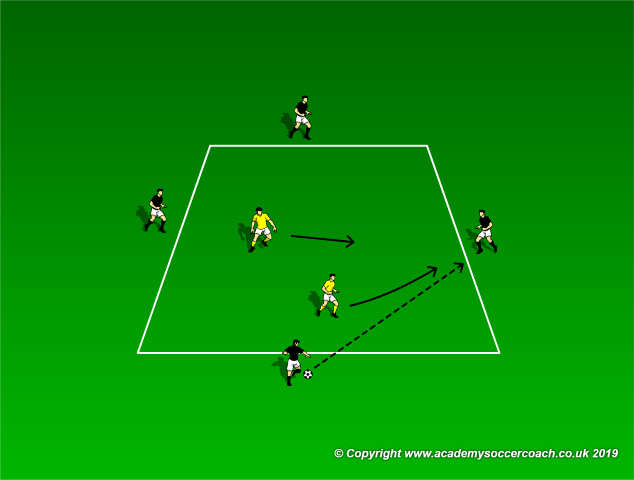
Although this activity is a warm-up, it targets the development of the players to collaborate together to win the ball. This way the defenders MUST communicate both verbally and non-verbally to adjust their positioning in such a way that force the attackers to commit errors and lose the ball.
Speed, Agility and Quickness: Agility plus 1v1 to score.
Targeted outcomes: 1, 6 and 7.
Duration: 10 minutes – 2 x 4 minutes interspersed with two minutes of rest.
Players: Two groups of attackers and a group of defenders.
Area: 20 yards in length by 12 yards in width.
Description: The attackers starts slaloming around the red poles at speed prior to exploding into space to finish at goal. The defender starts at the same time by shuffling between the yellow poles and then defends against the attacker. Reverse roles after every repetition. After a series of eight repetitions, have the attacker dribbling around the yellow poles while the defender shuffles around the red poles. As a progression the defender shuffles backwards.
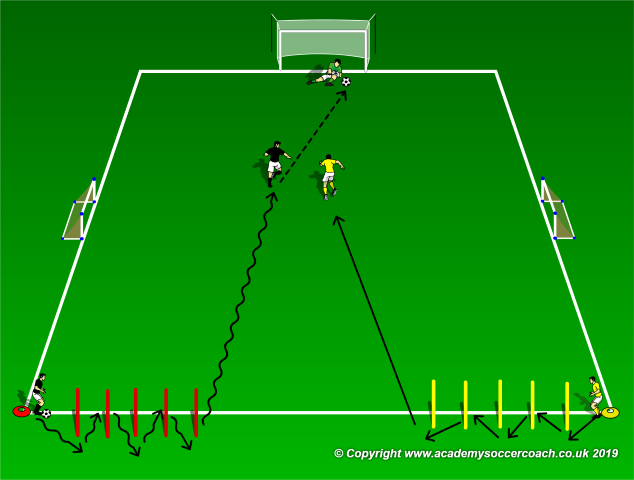
This exercise focuses on quickness and speed development while integrating the principles of individual defending. To make the activity more game realistic, after winning the ball, the defender aims to score in either of the two mini goals positioned on the side of the marked area. This simulates the start of a counter attack.
Individual tactical training situation: 1v1 with his back to the defender.
Targeted outcomes: 1, 2, 6 and 7.
Duration: 10 minutes.
Players: Have two setups with each consisting of four attackers, four defenders and a goalkeeper in goal.
Area: 20 yards in length by 12 yards in width.
Description: Attacker A1 passes to attacker A2 while the latter is pressed by the defender (D). Attacker A2 tries to score in the regular goal while the defender aims to win the ball and counter on the two mini goals positioned on the opposite end line.
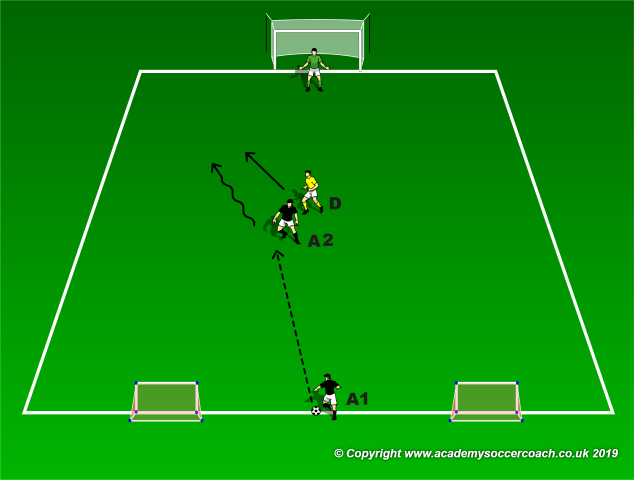
Prepared questions for the players:
How can the defender prevent the attacker from turning? The defender should remain diagonally behind the attacker, low on the knees and at a touch-tight distance from him.
Which side should the defender force the attacker to turn? The defender should force the attacker to turn towards his weaker foot.
When should the defender aim to win the ball? The moment the attacker is half turned and the ball is thus exposed, the defender positions himself between the attacker and the ball.
Progression to the previous training situation: 1v2 protect the goal.
Targeted outcomes: 1, 2, 4, 6 and 7.
Duration: 10 minutes.
Players: Have two setups with each consisting of four attackers, four defenders and a goalkeeper in goal.
Area: 20 yards in length by 12 yards in width.
Description: Attacker A1 passes to A2 while the latter is contrasted by the defender (D). The two attackers aim to score in the regular goal defended by the goalkeeper while the defender aims to prevent the attackers from scoring and launch a counter attack on the two mini goals.
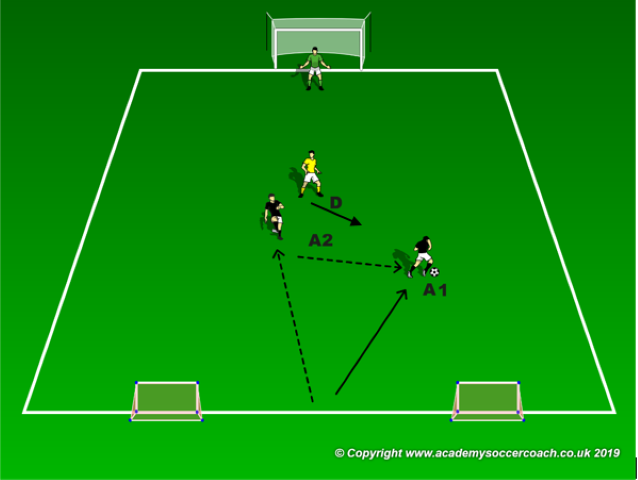
Prepared questions for the players:
What is the defender’s main aim? To win the ball and counter.
How should the defender’s initial position be? Between the ball and goal, and where he can have both attackers in his field of vision.
How may the defender win the ball? By forcing play away from goal, narrow the shooting angle, and eliminate the attacker’s space and time to play.
When should the defender attack the ball? When the opponent has a bad touch on the ball and/or when the option to pass to the second attacker is removed.
Small group tactical training situation: 2v3 plus recovering defender.
Targeted outcomes: All.
Duration: 15 minutes.
Players: Have two setups with each consisting of attackers, defenders and a goalkeeper in goal. Players take turns to work and rest accordingly. Therefore, after every attack players are rotated.
Area: 30 yards by 20 yards.
Description: Every attack starts with the players positioned as shown in the diagram below. The first part of the exercise is a goalkeeper plus two defenders against three attackers. This continues for approximately eight seconds until the recovering defender (highlighted) sprints back to defend. The signal to defend back is either given by the coach or by having the recovering defender complete some kind of exercise prior to defending.
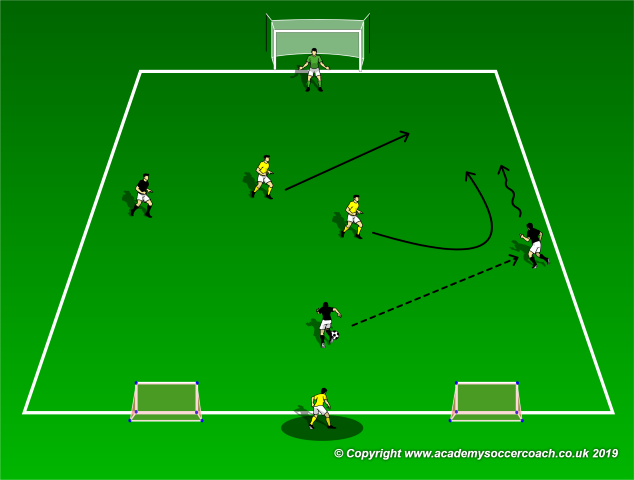
Prepared questions for the players:
Until the third defender recovers, what is the two defenders main aim? To remain compact and delay the attack.
How should the defenders aim to win the ball? By forcing play away from goal and outnumber the attacker on the ball to cut off his playing options.
Small sided game: 6v6 including goalkeepers in two horizontal zones.
Targeted outcomes: All.
Duration: 20 minutes – three sets of five minutes with two minutes rest in between.
Players: Both teams have a goalkeeper and five outfield players.
Area: 40 yards by 30 yards.
Description: In zone B the defending team has two players who are only active when their team is in possession of the ball. Therefore, the attacker in this zone may not be contrasted during the build-up of an attack. In zone A, play is 4v3 plus goalkeeper in favour of the attacking team. If the defenders win the ball, play becomes 5v5 plus goalkeeper with no restrictions. Therefore integrating both zones A and B together to form a single zone where players may move anywhere. When the ball goes dead, play restarts from the black team’s goalkeeper as already described. Play the final set as a normal match without zones.
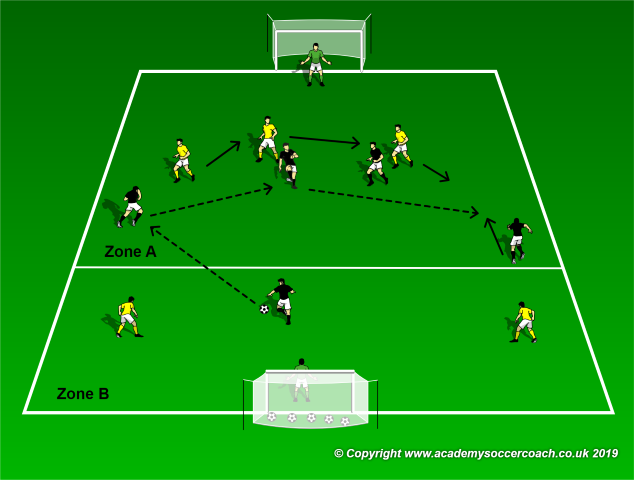
The aim of having the first part of the exercise as a 5v3 plus goalkeeper is to develop collaboration and also game insight in the phase of non-possession between the three defenders and the goalkeeper. The three defenders should learn to remain compact, patient and attack to win the ball at the right time. The goalkeeper should also develop his communication skills by guiding the team from the back.
Conclusive part.
Duration: 10 minutes.
In the conclusive part the players perform static stretching exercises with particular emphasis on the quadriceps, hamstrings, adductors and glutes. During this time the key outcomes of the session should be reviewed with the players.
By Philip Cauchi


